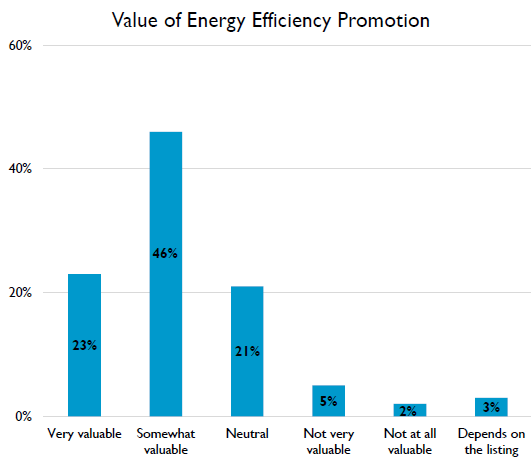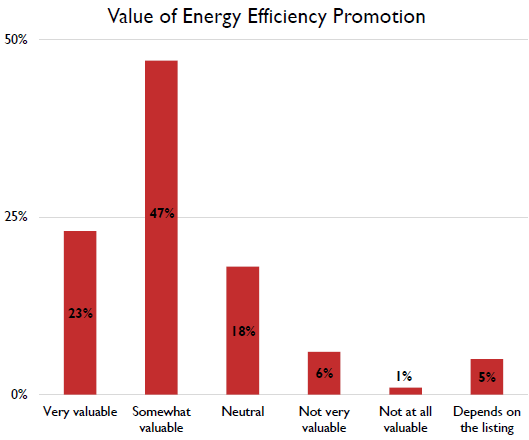
For the second year in a row, the National Association of Realtors® (NAR) released their sustainability report, which is filled with useful insights for those of us working at the nexus of energy efficiency and real estate.
While the report show that energy efficiency is valued in listings, it is also clear that significant work is needed to ensure energy efficiency features are visible and understood during real estate transactions. Those who work on energy efficiency programs are in a unique position to ensure Realtors have the tools and education so efficiency measures are evident at the time of sale.
What are the report’s key findings?
MLS Green Data Fields are Under-Utilized
Green data fields are a useful tool that enable Realtors to showcase energy efficiency features and certifications during the time of listing. Examples of green data fields include ENERGY STAR, LEED certified, HERS index score and low flow fixtures. Green fields vary depending on the multiple listing service (MLS), which is where residential properties are listed, or the commercial information exchanges (CIE), which is a data base of commercial property listings.
The NAR report shows green fields are underutilized across real estate sectors—less than half of real estate agents reported seeing green fields on their MLS, CIE or equivalent— but the problem is particularly pronounced in the commercial sector, where only 8% of respondents use them at all. Clearly, much work is to be done to improve awareness and usage of green data fields.
Realtors Value Energy Efficiency in Listings (Especially in the Midwest)
The results weren’t all so sobering. A vast majority of agents and brokers said that they found energy efficiency promotion in listings to be very or somewhat valuable across residential and commercial sectors. The survey also broke out responses by region, and efficiency is even more popular in the Midwest for the residential sector, where 73% of respondents said energy efficiency promotion in listings was valuable.
Since agents value energy efficiency in listings, it is crucial for programs to provide them with the information they need to highlight these features. Home Performance with ENERGY STAR certificates of completion are a great example of a program best-practice to ensure EE features are communicated during the time of sale. These certificates highlight the often-invisible upgrades that have been done to the home and provide the Realtor with the information needed to ensure the work that was done is associated with the home’s listing.


‘High Performance’ Branding and Green Certifications are Missed Opportunities (But There’s Hope)
NAR defined a ‘high performance home’ as ‘a systematic building science approach to home improvements that can increase indoor comfort, health, operational efficiency and durability.’
What impact does ‘high performance’ have on resale value? 53% of respondents indicated they were unsure. 16% of respondents saw an increase of 1 – 5% compared to other similar homes, while 17% saw no impact compared to other similar homes. For commercial properties, do green certifications such as LEED, Green Globes or Living Building Challenge increase commercial property values? Just 38% of respondents said green certifications increase property values.
The takeaway is that it is really unclear if agents are seeing an impact or not for both residential and commercial sectors.
However, this is not surprising considering the usage (or lack thereof) of the MLS and CIE green data fields. If an agent is not highlighting energy efficiency features and certifications during the time of sale, of course a buyer is not going to pay a premium for features that they do not even know are found within the property.
What Efficient Features Do Buyers Value?
Here’s what residential agents said were important features to their clients:
- Comfortable living space (95%)
- Home’s utility bills and operating costs (77%)
- Efficient lighting (48%)
- Smart and connected home (41%)
Note that a comfortable living space is the single most important feature to clients. This should be great news to us working in the energy efficiency space, as energy efficiency upgrades also improve occupant comfort by providing consistent temperatures, reducing drafts and more. However, it is imperative that Realtors also understand this. Programs can help by continuing to use ‘comfort’ in the messaging and marketing of energy efficiency.
Commercial agents were asked what they believe to be the most important building features to their clients:
- Utility and operations costs (81%)
- Efficient use of lighting (67%)
- Indoor air quality (64%)
- Smart and connected building (49%)
Transparency about energy and efficient features would help match clients to desirable properties.
There are Several Market Barriers to Consider
Understanding lending options for energy upgrades or solar installations remains a major barrier both residential and commercial agents face, along with the energy efficiency of existing housing and building stock and a lack of MLS/CIE data about home and building performance.
Programs can help by providing Realtors with information on energy efficiency financing, ensuring programs are available that target existing residential homes and commercial buildings and working with their local MLS/CIE to adopt green data fields.
Comfort with Clients’ Questions about Home Performance
While many agents (39%) said they were comfortable answering questions about home performance, 1 in 4 said they were uncomfortable, and 1 in 3 were unsure.
Energy efficiency programs often work to educate contractors or homeowners on energy efficiency, but real estate professionals also benefit by understanding these concepts. To that end, NAR has developed a two-day Green Designation course that educates agents on energy efficiency. However, this course is an elective course and not always offered through the local associations. Those who work on energy efficiency programs can work through their local association to encourage them to offer this course, perhaps even providing a stipend to enable them to offer it at a discounted rate.
Energy Efficiency Incentives and Requirements
Commercial Realtor awareness of utility rebates (73%) and federal tax incentives (56%) for energy efficiency is high, while fewer respondents were aware of state (42%) and local (26%) tax incentives.
Also notable, 38% of respondents had clients that were subject to energy benchmarking requirements (either at the city, county or state level), but less than 10% said they actually knew the requirements. This gap reveals an opportunity to better educate commercial real estate professionals on benchmarking.
Conclusion
For both residential and commercial energy efficiency sectors, Realtors must be considered to ensure that investments in energy efficiency measures are realized at the time of sale. MEEA has been working to educate the real estate sector on energy efficiency since 2014 and has touched hundreds of real estate professionals through educational lunch and learns, outreach events and trainings focused on energy efficiency.
If you would like to learn more about engaging real estate professionals or energy efficiency’s role in real estate listings , please reach out to Kara Jonas at KJonas@mwalliance.org.
You can access NAR’s complete report at https://www.nar.realtor/sites/default/files/documents/2019-Sustainability-Report-04-19-2019.pdf.